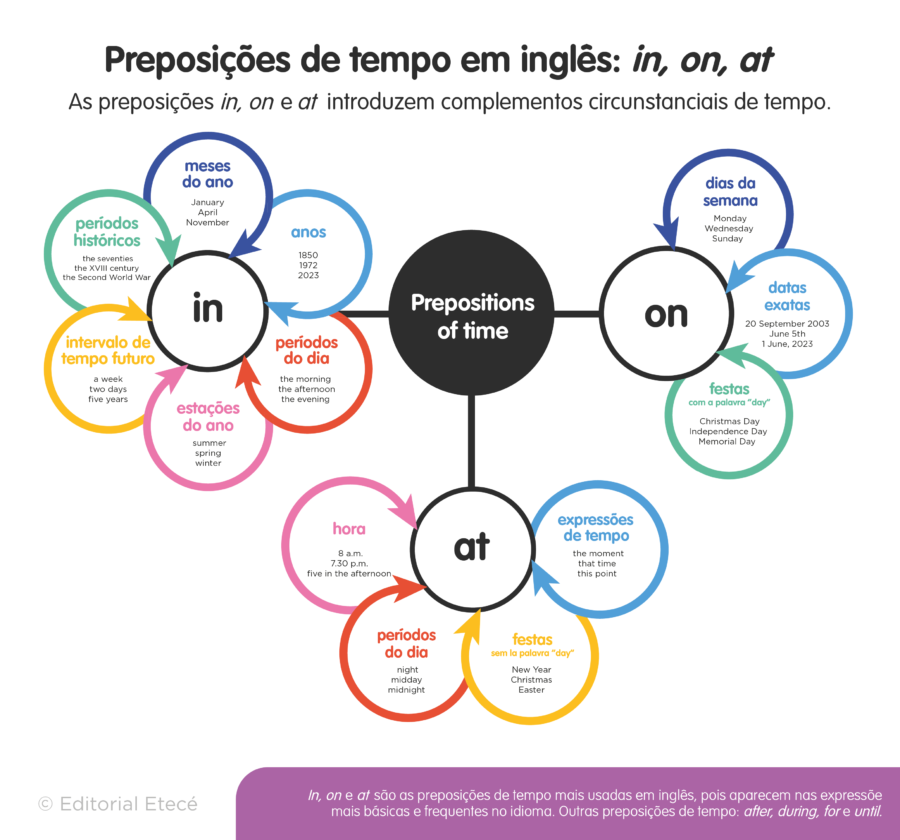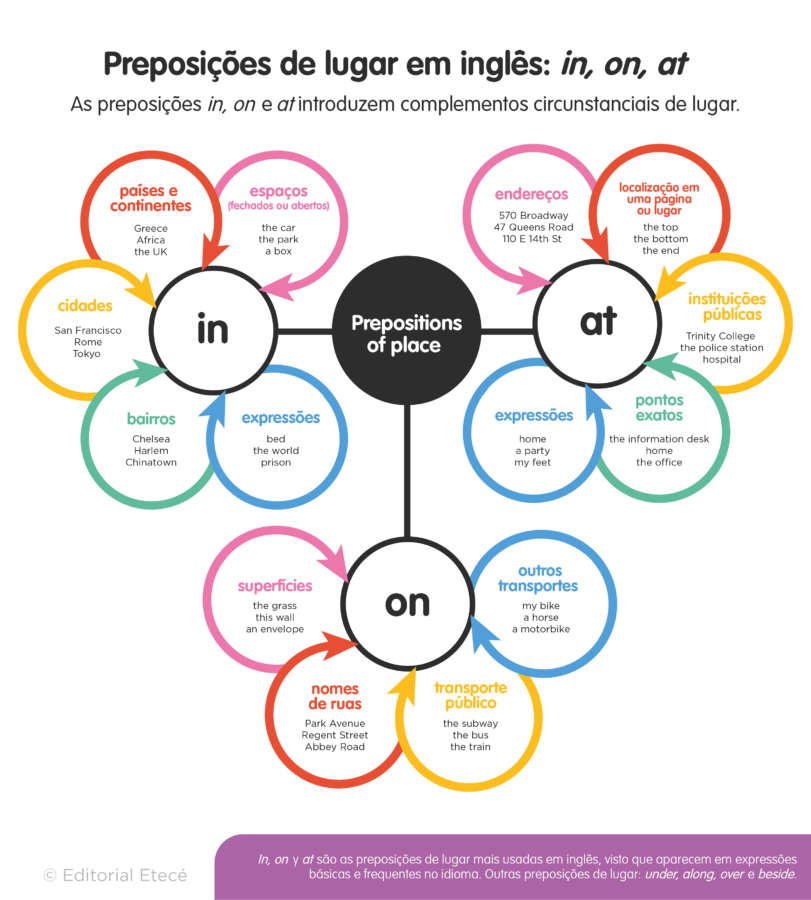Índice
As preposições em inglês, prepositions (in, on, for), são elementos gramaticais que ajudam a estabelecer uma relação entre palavras. Muitas vezes não têm um significado único, mas varia de acordo com o contexto. Por exemplo: Dad is coming for us at 8 p.m./Papai virá nos buscar às 8 da noite.
De acordo com o tipo e o contexto, as preposições em inglês podem indicar:
- destino (to)
- procedência (from)
- lugar (at, in, on)
- finalidade (to, for)
- tempo (during, since, at)
As preposições em inglês podem ir antes ou depois de um substantivo ou frase substantiva (on the table), depois de um verbo (come on), e antes ou depois de um pronome (for him).
- Veja também: Conjunções em inglês
Preposições de tempo em inglês: Prepositions of time

As três preposições mais utilizadas são in, on, e at.
Quando usar IN? (tempo)
Quando se refere ao tempo, a preposição IN significa “em”:
| Usos de in | Com palavras como… | Exemplo |
|---|---|---|
| Momentos do dia | the morning, the afternoon, the evening | Naomi does yoga in the morning. |
| Meses | March, May | We got married in September. |
| Anos | 1995, 2012 | The pandemic broke out in 2020. |
| Estações do ano | summer, fall, winter, spring | We always go to the beachin the summer. |
| Períodos de tempo | the nineties, the XV century, the Second World War | Shakespeare was born in the sixteenth century. |
Quando se usa ON? (tempo)
Quando se refere ao tempo, a preposição ON pode significar “o”, “os” ou “em”, de acordo com o contexto.
| Usos de on | Com palavras como… | Exemplo |
|---|---|---|
| Dias da semana | Monday, Friday morning, Saturday afternoon | I take English classes on Mondays and Wednesdays. |
| Fechas | January 1st, September 30th | They’re arriving on December 4th. |
| Algumas festividades (incluindo a palavra Day) | Christmas Day, Memorial Day, Halloween, Independence Day | We were in New York on Memorial Day. |
Quando se usa AT? (tempo)
Quando se refere ao tempo, a preposição AT significa “às”, “à”, “em”.
| Usos de at | Com palavras como… | Exemplo |
|---|---|---|
| Hora | 7 a.m., about 5 p.m., 10 in the morning | We usually go to bed at about 11 p.m. |
| Momentos do dia | night, midnight, midday, lunchtime | They made the excursion at night. |
| Festividades (que não inclui a palavra Day) | Easter, Christmas | The family will get together at Easter. |
| Expressões fixas | that time / moment / point | At that point I realized it was time to go. |
- Veja também: Preposições de tempo «in», «on» e «at»
Outras preposições de tempo
Outras preposições que se utilizam em relação ao tempo são:
| Preposição de tempo | Significado | Exemplo |
|---|---|---|
| about / around | em torno de…/mais ou menos… | I get up at about 7 a.m. every morning. |
| after | depois | We went to eat out after the movie. |
| before | antes | I’ll study every day before the test. |
| between | entre | They always have lunch between 12 p.m. and 2 p.m. |
| beyond | além de | Your reservations won’t be held beyond 24 hours. |
| by | para (o), (as) | I have to get this finished by Friday. |
| during | durante | My great-grandfather came to America during WWII. |
| from | de/desde | Banks in Argentina are open from 10 a.m. to 3 p.m. |
| for | por/durante | Tom has lived in England for a year. |
| past | depois | Children, it’s past your bedtime! |
| since | desde | My mother has been working for NASA since 2018. |
| throughout | durante/ao longo de | He coughed throughout the concert. |
| until | até | I’ll be here until 10 p.m. |
| within | dentro de/em menos de | Within 15 minutes of the accident, help had arrived. |
Atenção: A preposição by implica uma data limite; a ação pode se desenvolver antes. Por exemplo: You need to hand in the report by the end of the week.
Preposições de lugar em inglês: prepositions of place

As preposições de lugar que expressam localização mais utilizadas em inglês são in, on e at. Elas são usadas junto com verbos estáticos (que não envolvem movimento), be, live, study.
Quando usar IN? (LUGAR)
Quando se refere ao lugar, a preposição IN significa “em”, “dentro”. Implica que a pessoa ou coisa está compreendida dentro de um espaço.
| Usos de in | Com palavras como… | Exemplo |
|---|---|---|
| Espaços (fechados ou abertos) | he kitchen, the garden, the city center, the bag, the sea | Can you give me the pen that is in my pencil case? |
| Países | the U.S., France, England | They live in England. |
| Cidades | New York, Paris, London | I’ll be in London next week. |
| Bairros | West End, Soho, Kensington | Sam studies in Kensington. |
Atenção: A preposição in é também utilizada nas seguintes expressões: in bed, in prison, in the world, in the sky, in a photo, in a car, in the middle of… In a book, in a newspaper, in a magazine.
Quando usar ON? (LUGAR)
Quando se refere ao lugar, a preposição ON significa “em”, “sobre”. Implica que a pessoa ou coisa não está dentro de um espaço, mas está sobre ele.
| Usos de on | Com palavras como… | Exemplo |
|---|---|---|
| Superfícies | table, shelf, floor, page | We sat on the grass and had a picnic |
| Nomes de ruas | Kensington Road, Victoria St, 5th Avenue | We bought the flowers at a shopon Kensington Road. |
| Transporte público (exceto táxi) | bus, train, subway, plane, ship | I always read on the bus. |
Atenção: A preposição on também é utilizada em: on a bike, on a horse, on a motorbike.
Quando se utiliza a preposição AT?
Quando se refere ao lugar, a preposição AT significa “em”. Implica um ponto exato.
| Usos de at | Com palavras como… | Exemplo |
|---|---|---|
| Endereços exatos | 720 Victoria St, the Mall, | My friend lives at 12 Oxford St. |
| Pontos exatos | the bus stop, the studio, the door, the traffic lights | I saw Peter at the bus stop. |
| Instituições e lugares públicos | university, school, the theater, the library | Let’s meet at the library.. |
| Posição em uma página | the bottom, the top, the end | Please sign at the bottom of the page. |
Atenção: A preposição at se utiliza nas seguintes expressões: at home, at work, at the station, at the airport, at a party/concert/match, at somebody’s house.
Outras preposições de lugar
Existem outras preposições de lugar, que podem dar o sentido de:
- Localização, se são usadas em contextos de verbos estáticos, que não envolvem movimento (be, live).
- Movimento, se usadas em contextos de verbos dinâmicos, envolvendo movimento (run, go).
| Preposição de lugar | Significado | Exemplo |
|---|---|---|
| above | sobre/acima de/em cima | During the flood, water rose 2 meters above sea level. |
| across | cruzando/em frente | My grandparents live just across the street. |
| along | ao longo de/ao lado de | I love to run along the beach. |
| around | ao redor de | They have put a fence around the park |
| against | contra | Please don’t lie back against this wall. |
| behind | detrás/atrás de | The child is hiding behind that wall. |
| beside | junto a/ao lado de | Mary is the girl sitting beside Mr. Jones. |
| below | abaixo/abaixo de | She always wears skirts below the knee. |
| beneath | abaixo de/baixo | Beneath that hard exterior lies a sweet kind person. |
| between | entre | At work, I usually sit between Jake and Mel. |
| by | junto com/ao lado de | Grandma sits by the fire for hours on end. |
| down | seguindo por/abaixo | Our store is down the road. |
| in front of | em frente de/frente a | There’s a treein front of the house. |
| inside | dentro | They stayed inside the hotel complex the whole weekend. |
| near | perto de/próximo a | Excuse me, is there a drugstore near here? |
| opposite | em frente | My friend sat opposite me on the train. |
| outside | fora/fora de | I’ll be waiting outside the office. |
| over | por cima de/sobre | My mom has ornaments over the fireplace. |
| under | baixo/abaixo de | The dog is under the tree. |
| underneath | baixo/debaixo | There are many tunnels underneath the city. |
| up | em cima | They have a cottage up the hill. |
| upon | sobre (equivalente a on em inglês literário) | The principal had a black cloak upon his shoulders. |
Cuidado:
- Há preposições que são utilizadas exclusivamente com verbos dinâmicos, que expressam movimento (e não localização). Estas são: to (a, para), through (através), towards (para).
- A preposição in front of significa “em frente” e não “frente” no sentido literal em português, para o qual se utiliza across (ou opposite) em inglês. Por exemplo: They live across. (E não: They live in front).
Outras preposições em inglês
Existem outras preposições que são utilizadas em contextos diversos:
| Preposição | Significado | Exemplo |
|---|---|---|
| about | ao redor/sobre/a cerca de | Bonnie has read an interesting article about butterflies. |
| away from | longe de | Away from her family she felt lonely and depressed. |
| for | para | We’ve bought a beautiful dress for Margarita.. |
| from | de (denota origem ou proveniência) | He’s from France. |
| of | de | The leg of the table is broken. |
| off | fora de/de/perto | Who’s taken my dictionary off my desk? |
| per | por | He goes to the gym three times per week. |
| to | a/para | We’re traveling to the coast next weekend. |
| towards | para/a | They headed towards the Capitol. |
| with | com | I went out with my friends last night. |
| without | sem | He’s the best player, without any doubt. |
Atenção:
- Existem as phrasal verbs (expressões verbais), que são a combinação de um verbo mais uma preposição (ou dois), que juntos formam um novo verbo. Nesses casos, a preposição faz parte da phrasal verb, e seu significado não deve ser entendido separado do verbo. Por exemplo: read through (revisar, analisar. E não: ler através)
- As preposições podem aparecer em expressões fixas, com um sentido idiomático e não literal. Por exemplo: on my way home (caminho para casa).
Continue com:
Esta informação foi útil para você?
Sim NãoGenial! Obrigado por nos visitar :)